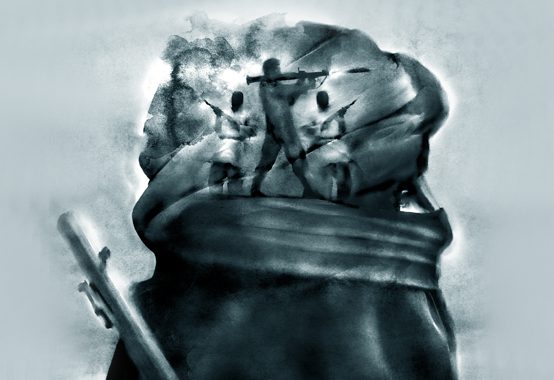Gangsta Jihad

Forgive the cliché: This book is essential reading. No hyperbole required.
The New Threat—“new” in the sense that the danger posed by violent Islamism is evolving—deserves the careful attention of anyone appreciating the urgency of the West recalibrating its response to that danger. The U.S.-led Global War on Terrorism, which Jason Burke aptly characterizes as “monumentally misconceived,” has definitively failed. Indeed, in anything, it has made matters worse. Even so, more than a decade after it began, that ill-fated enterprise sputters along with no likelihood of victory anywhere in sight.
So perhaps it’s time to try a different approach. Yet doing so requires first accurately gauging the problem. This Burke, a veteran journalist who over the past 20 years has reported from virtually every corner of the Islamic world, does with impressive thoroughness and clinical dispassion. That the terrorist attack suffered by Parisians in November-—further compounded by the incident in San Bernardino—elicited a response verging on hysteria may be understandable. But anyone preferring sober calculation to emotion as the basis for policy will find here much of great value.
By no means does Burke trivialize the threat or question its existence. But he argues that to treat that threat as existential is to commit a categorical error. So too is any tendency to view Islamic militancy as monolithic or static.
During the Cold War, American political leaders propagated an erroneous conception of communism as one thing—vast, integrated, cohesive, and responding to central command. Their failure to discriminate among the several versions of communism and to appreciate the fault lines within the communist world led them to commit costly blunders, with Vietnam one notable example.
 Burke cautions against making a similar mistake here. Islamic militancy, he writes, is “diverse, dynamic, fragmented and chaotic.” His own typology identifies three distinct strands: 1) organizations animated by grandiose ambitions, this group consisting of al-Qaeda central and the Islamic State; 2) lesser entities, some of them al-Qaeda affiliates but also including sundry independent actors scattered everywhere from West Africa to Central Asia and all the way to the southern Philippines; and 3) what Burke calls “the movement of Islamic militancy” consisting of radicalized individuals, many of them already residing in the West, who are engaged in waging “leaderless jihad.”
Burke cautions against making a similar mistake here. Islamic militancy, he writes, is “diverse, dynamic, fragmented and chaotic.” His own typology identifies three distinct strands: 1) organizations animated by grandiose ambitions, this group consisting of al-Qaeda central and the Islamic State; 2) lesser entities, some of them al-Qaeda affiliates but also including sundry independent actors scattered everywhere from West Africa to Central Asia and all the way to the southern Philippines; and 3) what Burke calls “the movement of Islamic militancy” consisting of radicalized individuals, many of them already residing in the West, who are engaged in waging “leaderless jihad.”
As Burke sees it, Americans and others in the West tend to misunderstand and overstate the danger posed by groups in the first category while failing to appreciate their vulnerabilities. Not unlike the Soviet Union and the People’s Republic of China in the old days, al-Qaeda and ISIS are competitors, not partners—which is good news for us.
The violence perpetrated by these groups is anything but random. Both adhere to a clear set of strategic principles. Osama bin Laden’s original al-Qaeda assigned priority to the “Far Enemy,” preeminently the United States. Purging the lands of Islam of foreign infidels—first drawing them further in before making their further presence unsustainable—would enable al-Qaeda later to redirect its attention to corrupt local regimes, preeminently in Saudi Arabia. Ousting those regimes formed a prerequisite to reforming Islam itself, with the creation of a pan-Islamic caliphate the ultimate goal.
Today that goal is nowhere within reach. Burke describes al-Qaeda as “tenacious and resilient, with significant powers of regeneration.” Even so, having sustained serious blows since 2001, it is today a shadow of its former self.
ISIS has emerged as its successor. In contrast to al-Qaeda, ISIS prioritizes the establishment of a territorial base. Declaring the existence of a caliphate, if only an embryonic one, figures as a first step, not a culminating one. This means going after the “Near Enemy”—weak regimes vulnerable to dismemberment. In that regard, Iraq, unable to fend for itself after years of foreign occupation, and Syria, rent by years of civil war, present inviting opportunities.
In any terrorist campaign, the image is as important as the act. As much or more than the actual doing it’s what perpetrators of terror are seen to have done—and are presumably capable of doing again—that matters. In that regard, ISIS has demonstrated a particular aptitude for staging acts of violence that strike fear into the hearts of opponents, while nudging fence-sitters into choosing sides and rallying supporters “by demonstrating the group’s power and success.” Videos, flags, music, orange jump suits, and vicious executions—the entire package is assembled with as much forethought as the Nuremburg rallies of the 1930s. For all the hype about the role played by social media, that’s merely the mode of transmission; the genius, if we can call it that, is in the content.
Yet for all its darkly impressive feats of propaganda, ISIS is surely not in the same league with the Third Reich. Burke cautions against exaggerating its strength. The Islamic State, he writes, “is economically fragile, lacks skilled workers, has problems providing basic services to its population, and suffers from both massive underinvestment in infrastructure and a prodigiously unequal distribution of wealth.” Militarily it has benefited from the absence of serious opposition on the ground—the Iraqi army lacking the will to fight and the Syrian army having its hands full with other priorities.
Most importantly, the extent to which ISIS relies on raw coercion to enforce its writ will limit its appeal. As with other brutal and tyrannical regimes, its own excesses will elicit internal resistance and may ultimately spell its demise. When the alternative on offer is beheading or crucifixion, the Islamic State may for a time succeed in enforcing sullen compliance. But it is not a project likely to win the hearts and minds of the masses.
Appearing shortly before the Paris attacks, The New Threat emphasizes the differences between al-Qaeda and ISIS. Since then, he has adjusted his interpretation, writing in the Guardian that ISIS has now “gone global” and appears to be “following a similar trajectory” to al-Qaeda.
My own sense is that Burke may have prematurely abandoned the argument presented in his book. Even after Paris and San Bernardino, the territoriality of ISIS remains its foremost distinguishing feature, both a mark of prestige and a liability. To preserve its “state,” ISIS has to defend it. The challenge facing the West is to find ways of driving up the costs of that defense, thereby subjecting ISIS to continuous stress, but without succumbing once more to the illusion that invade-and-occupy offers a shortcut to success. In that regard, the United States and its allies need to mobilize those that ISIS views as its “Near Enemies” to do the job that is rightfully theirs anyway.
In Burke’s second category of Islamic militancy, the splintered and far-flung terror groups, constituent members tend to pose a far greater threat to Muslims inhabiting weak states across the Greater Middle East than to people of whatever religious persuasion living in the United States or Europe. According to Burke, al-Qaeda in the Arabian Peninsula, an offshoot of the original al-Qaeda, may represent a partial exception to this generalization. But the other affiliates, auxiliaries, and wannabes tend to be local in their origins, agenda, and reach. The peoples afflicted by these extremist groups deserve Western assistance in restoring (or establishing) the rule of law. But unless you’re Somali or Nigerian, to lie awake at night worrying about the likes of al-Shabaab or Boko Haram is to lose sleep for no purpose.
It’s category three, however, to which Burke wants to call particular attention. This is the emerging face of Islamic militancy: alienated individuals or very small groups with “no overall authority and no orders from self-appointed leaders” but able to terrorize Western populations through occasional, seemingly random acts of violence.
The very openness of Western societies makes them particularly susceptible to attacks of this type, which come with a disconcerting suddenness, as if out of nowhere. Averting such events, especially when launched by perpetrators who are already within the gates, greatly challenges the capacity of police forces and intelligence agencies. Indeed, 100 percent success in preventing them is no more likely than a comparable rate in preventing murder or armed robbery.
The Boston Marathon bombing of April 2013 offers a close-to-home example of this phenomenon, an atrocity engineered by two nondescript young men, both Muslim, both longtime residents of the United States, the one apparently self-radicalized, the other compliantly following the orders of his older brother. The San Bernardino episode bears similarities.
At one level, we may see the result as sheer nihilism, a murderous act by two alienated personalities—lone wolves lashing out on their own. Burke challenges that perception, arguing that “the lone wolves are not really lone but embedded within a much wider and deeper culture of Islamic militancy.” Here is the real problem, although it bids fair to be far more urgent for the ex-colonial European powers than for the United States.
The lone wolves travel in packs that may be real but are just as likely to be virtual. According to Burke, “they resemble gangs or other equivalent communities.” Just as gang culture grips certain neighborhoods of Boston, Chicago, or LA, so too in parts of East London or among the poorer suburbs ringing Paris something similar has occurred. The founding narrative may differ, but the appeal is much the same, offering members “a sense of empowerment,” along with “purpose, companionship, status, excitement, adventure and the prospect, frequently realized, of both material and sexual advantages.” Burke calls it “jihadism with gangsta criminality.”
The gangs with which residents of major American urban centers have become familiar are unlikely to take over city hall, but they have proven exceedingly difficult to eradicate. So too with young gangsta jihadists who see little opportunity for living a productive life even as they feed on a constant diet of historical resentments, theological distortions, and “apocalyptic prophecy.”
The delusions to which they subscribe are nothing short of bizarre. Of course, so too are the delusions of the Americans who cling to the discredited belief that military power offers a quick and easy solution to the mess we’re in. Burke knows better. “The idea that some kind of silver bullet exists,” he warns, is “without foundation.”
Andrew J. Bacevich is professor emeritus of history and international relations at Boston University. His new book, America’s War for the Greater Middle East: A Military History is due out in April.
Comments